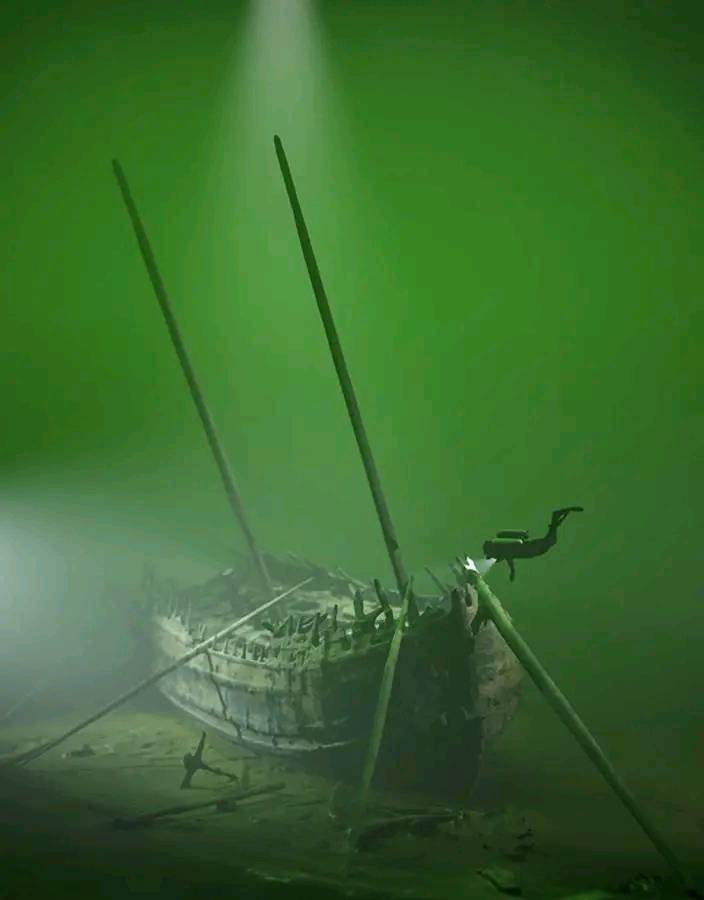In 2017, a discovery in Stockholm’s archipelago reshaped our understanding of Scandinavia’s maritime history. Beneath 28 meters of water, archaeologists from Sweden’s National Maritime Museum unearthed a merchant vessel whose preservation offered an extraordinary glimpse into the 16th century. This discovery opened a new window into the intricate trade networks and maritime craftsmanship of the era.
An Architectural Masterpiece Carrying Precious Cargo
Measuring 20 meters in length and 7.5 meters in width, the vessel showcased a unique blend of medieval and Renaissance shipbuilding techniques. Its robust design reflected the ingenuity of Scandinavian maritime engineers. Inside, the ship carried what was arguably its most fascinating feature – thirty barrels of Osmond iron, a highly refined metal critical to the booming industries of the time. This remarkable cargo, preserved by the Baltic Sea’s cold and low-salinity waters, remains a treasure trove for understanding Europe’s industrial past.

The Unique Role of Osmond Iron
The significance of Osmond iron cannot be overstated. This refined iron, forged into small, spherical pieces, was Scandinavia’s prized export during the 1500s. It powered industries across Europe, particularly in Germany and the Netherlands, where its durability and quality were in high demand. The discovery marked only the third recorded instance of Osmond iron being recovered from Baltic shipwrecks. This highlights not only its rarity but also Sweden’s pivotal role in shaping European commerce through metal trade during the Renaissance era.
A Glimpse Into Sailor Life
Beyond its cargo, the shipwreck offered an intimate look into the daily lives of sailors. The Baltic Sea’s unique environment preserved not just the vessel but also personal belongings, pottery, and tools that once belonged to the crew. Among these artifacts, researchers found items that painted a vivid picture of maritime culture. The ship’s structural integrity, including an intact mast, provided rare insights into the craftsmanship and daily operations aboard 16th-century merchant vessels.
Nature’s Role in Preservation
The Baltic Sea played a critical role in preserving this vessel. Unlike most oceanic environments where wooden structures quickly deteriorate, the Baltic’s low salinity, frigid temperatures, and absence of wood-eating organisms created ideal conditions for conservation. This natural preservation chamber allowed researchers to study the ship’s construction and its contents with remarkable clarity, offering invaluable knowledge about maritime trade and shipbuilding techniques of the time.
The Tragedy of Looting
While this discovery was a groundbreaking achievement for maritime archaeology, it also came with its share of tragedy. Despite efforts to keep the location of the wreck a secret, looters found and raided the site, stealing irreplaceable artifacts. As archaeologist Jim Hansson lamented, the theft was akin to “tearing pages from a book” – each stolen artifact represented a loss of historical knowledge. The looting underscored the ongoing challenges in protecting underwater cultural heritage.
Strengthening Protections for Underwater Heritage
The tragedy of looting sparked renewed efforts to safeguard underwater archaeological sites. Across the Nordic countries, governments and institutions are now implementing advanced surveillance systems and stricter regulations to deter looters. The incident also raised public awareness about the importance of preserving these irreplaceable historical treasures for future generations. Such measures are crucial in ensuring that discoveries like this vessel continue to educate and inspire rather than become lost to greed and negligence.
A Testament to Scandinavian Trade Prowess
Despite the losses caused by looting, the shipwreck remains a powerful testament to Scandinavia’s maritime heritage and trade expertise. Its discovery has illuminated the complex web of trade routes that connected Europe during the Renaissance, underscoring the strategic importance of Sweden and the Baltic Sea in shaping the continent’s economic landscape. Every artifact, structural detail, and preserved piece of cargo tells a story of innovation, resilience, and the interconnectedness of cultures through trade.
Lessons From the Past
The ship’s story, though marred by theft, serves as a poignant reminder of the importance of preserving cultural heritage. Its silent existence beneath the waves symbolizes the wealth of knowledge that lies hidden in the world’s oceans. These underwater time capsules not only teach us about the past but also inspire us to think critically about how we protect and value history in the modern era. The ship’s legacy continues to influence our understanding of maritime trade and craftsmanship, ensuring that its story endures for generations to come.
In conclusion, this 16th-century vessel, preserved by the Baltic Sea and brought to light by dedicated archaeologists, remains a cornerstone in the study of European maritime history. Its cargo of Osmond iron, its architectural ingenuity, and the personal artifacts of its crew provide an unparalleled glimpse into the past. Even in the face of loss and looting, the ship continues to teach us about Scandinavia’s significant role in shaping Renaissance-era trade. Above all, it reminds us of our shared responsibility to protect the cultural treasures that lie hidden beneath the waves.





